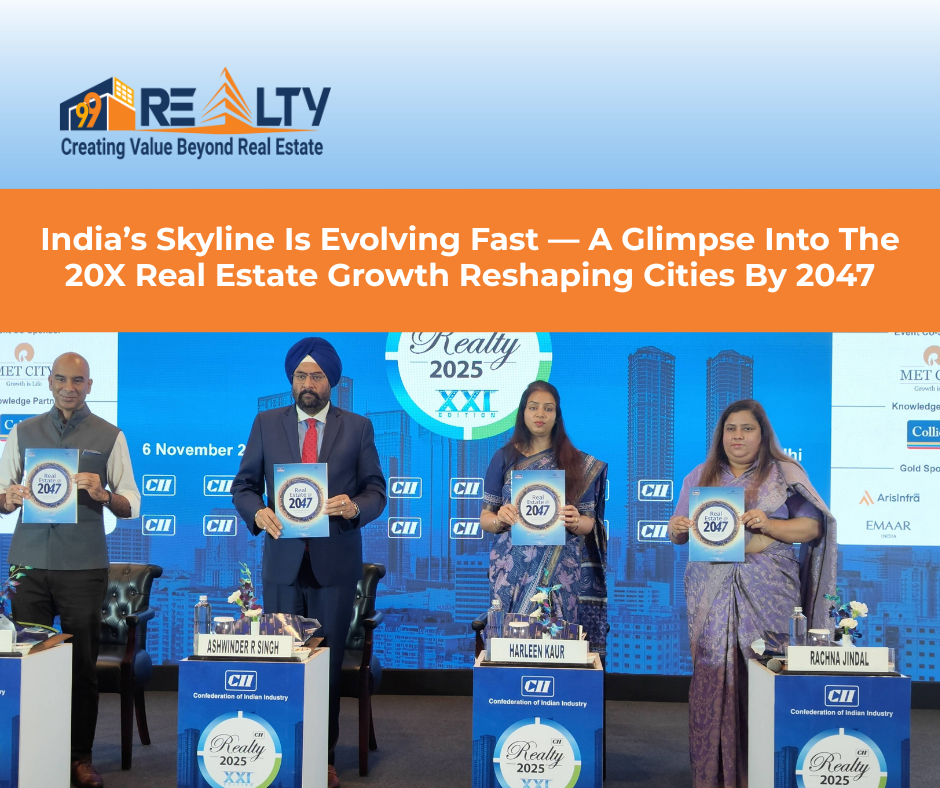What if the next two decades turned your city skyline into something you wouldn’t even recognize today?
That’s exactly what’s unfolding. According to the Colliers India–CII report, India’s real estate sector is gearing up for an unprecedented 20 X growth by 2047 — the year we celebrate 100 years of independence from colonial power.
This isn’t just another number thrown into the mix of economic optimism. It’s a glimpse into how our homes, offices, cities and our lives will evolve — redefining where and how Indians live, work, and invest.
Redefining Real Estate Marketing in 2025: A Comprehensive Guide for the New-Age Buyer
Setting the Stage: Why 2047 Matters
A Century of Independence, A New Urban Dream
2047 will mark a hundred years of India’s freedom. It’s not just a symbolic milestone — it’s a benchmark for transformation.
For policymakers and industry leaders, it’s a deadline to build a nation that’s globally competitive, sustainable, and inclusive. And at the heart of that transformation lies one key industry: real estate.
From affordable homes in emerging cities to smart business districts powered by AI and green energy — real estate will literally build the India of tomorrow.
The Centenary Vision & Real Estate’s Role
The report by Colliers India and the Confederation of Indian Industry (CII) identifies real estate as the cornerstone of India’s economic growth.
Why? Because real estate fuels over 250 allied industries — from cement to steel, banking to retail. It’s not just about buildings; it’s about building an economy.
Imagine 2047’s India: vertical green cities, high-speed connectivity, affordable homes powered by solar roofs, and commercial hubs thriving beyond metros. That’s the real “freedom” we’ll experience — the freedom to live better.
Unlocking the Secrets of Residential vs Commercial Property
Current Size vs Future Potential
Currently valued at around $1 trillion, India’s real estate sector contributes roughly 7–8% of GDP.
But by 2047?
$5–10 trillion market size
14–20% GDP contribution
20× growth impact across segments
That’s not just growth — it’s a real-estate renaissance.
Key Growth Drivers Behind the Surge
The Colliers–CII report breaks down the key catalysts behind this quantum leap. Let’s unpack them in simple terms.
1. Rapid Urbanisation and Demographic Shifts
From Rural to Urban: The Migration Tsunami
By 2050, nearly half of India’s population will live in cities.
Every year, millions migrate from rural areas to urban centers in search of jobs, education, and better lives.
That’s like adding a new city the size of Singapore every few months in terms of population demand!
And that means — more homes, more offices, more infrastructure.
The Youth Dividend & Family Structure Shift
India’s median age is 29 — among the youngest in the world. But by 2047, that number will move closer to 40.
What does that mean?
- More working professionals with disposable income
- More nuclear families
- Higher demand for urban apartments, co-living, and even senior-living communities
Basically, a full lifecycle of real-estate demand — from first-time renters to retirement homes.
2. Infrastructure & Connectivity Revolution
Expressways, Metro Lines & Economic Corridors
Every expressway, every metro line, every airport expansion — they don’t just connect cities; they create new cities.
Projects like Delhi–Mumbai Expressway, Bharatmala, and Gati Shakti are rewriting India’s geography.
Satellite towns like Sonipat, Nagpur, Jaipur, and Lucknow are emerging as the next investment hotspots — the places where today’s empty plots will become tomorrow’s skylines.
3. Digitalization, Sustainability & Diversification
Data Centres, Co-living & Senior Living Boom
Traditional real estate — housing and offices — will continue to dominate. But there’s a silent revolution brewing in alternative asset classes:
- Data Centres: To fuel India’s digital economy
- Co-living Spaces: For millennials and professionals
- Senior Living: For an aging but financially strong population
These segments will expand exponentially, adding billions to the sector’s value.
The Green Building Mandate
Sustainability is no longer optional. Net-zero buildings, solar-powered townships, water recycling — these will be the norm, not the novelty.
And guess what? Buyers will demand it. Investors will fund it. Developers who ignore it will simply be left behind.
What the Report Actually Says
Here’s a quick look at the Colliers India–CII report highlights (2025):
- The real estate market could touch USD 5–10 trillion by 2047
- Contribution to India’s GDP: 14–20%
- Office & industrial stock: 2 billion sq. ft.
- Emerging asset classes to account for ~25% of future growth
That’s a transformation on a scale never seen before in India’s urban history.
How Cities Are Changing: The Rise of Tier-II & Tier-III India
Metros are Saturated — Enter the New Growth Hubs
While Delhi, Mumbai, and Bengaluru remain the giants, the real action is shifting elsewhere.
Cities like Surat, Nagpur, Raipur, Indore, Jaipur, Lucknow, Kochi, and Coimbatore are evolving into economic magnets — thanks to new airports, industrial corridors, and education hubs.
They offer lower costs, younger populations, and massive untapped potential — perfect ingredients for the next real-estate revolution.
Why It Matters
For developers — this is the next frontier.
For investors — this is the window of opportunity.
For homebuyers — this is your chance to buy in cities that’ll double or triple in value by 2047.
Tier-II and Tier-III India are where tomorrow’s skylines are being drawn.
Why Tier 2 and Tier 3 Cities Are the New Investment Frontiers
Challenges & Caveats: Every Boom Has Its Bumps
Regulatory Hurdles & Oversupply Risks
While the growth story is solid, the path won’t be smooth.
Red tapism, project delays, and oversupply in select markets can derail momentum.
Affordability remains a serious challenge — especially when incomes don’t rise at the same pace as property prices.
The balance between demand and responsible development is delicate.
Sustainability & Climate Risks
Rapid construction without environmental foresight could spell disaster.
Cities like Chennai and Gurugram have already witnessed floods and groundwater depletion — clear reminders that real-estate growth must be green and resilient, not reckless.
The Colliers–CII report strongly emphasizes eco-friendly urban planning as the backbone of future growth.
Opportunities for You: How to Benefit from the 2047 Vision
Let’s get practical. Here’s how you can position yourself — whether you’re a buyer, investor, or developer.
For Homebuyers
1. Buy Smart, Not Fast:
Don’t just chase pre-launch discounts. Look for infrastructure-backed areas (near expressways, airports, or metro lines).
2. Plan Your Finances:
Use home-loan tax benefits, compare EMIs, and lock in fixed rates if possible. The earlier you buy, the more equity you build.
3. Think Long-Term:
2047 is 22 years away. Choose locations that’ll mature with you — think city extensions, not city centers.
For Investors & Developers
1. Diversify Your Portfolio:
Invest beyond residential — explore data centers, warehousing, senior housing, co-living, or REITs.
2. Tap Tier-II/III Markets:
Early movers in cities like Indore or Nagpur could see 2x–3x appreciation as infrastructure catches up.
3. Focus on Exit Strategy:
Build-in flexibility — market cycles are shorter now. Always have a “Plan B” to liquidate or repurpose assets.
Conclusion: The 2047 Horizon Is Closer Than You Think
When you picture 2047, don’t imagine something distant. It’s just 22 years away — the time it takes for a child to grow into an adult.
In that span, India’s cities will be reborn — smarter, greener, and bigger than ever before.
The Colliers–CII report isn’t just a forecast; it’s a wake-up call for everyone connected to this ecosystem — from the first-time homebuyer to the biggest real-estate conglomerate.
The question is simple: Will you watch the transformation or build it?
Need Help?
Need help evaluating a property or planning your next move in the market?
Reach out to 99 REALTY – your trusted real estate partner for smarter choices.
Subscribe to get updates on our latest posts and market trends.






Join The Discussion